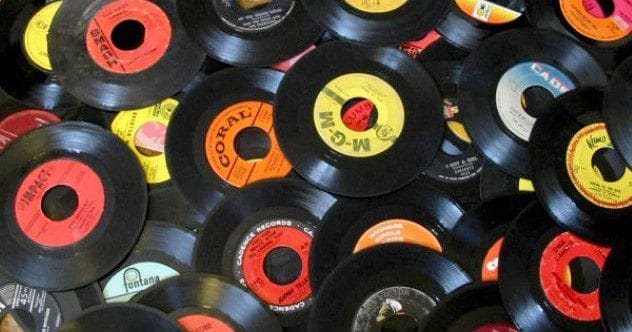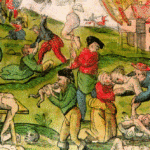Remember vinyl records? Before streaming and even CDs, music singles came on 45 rpm vinyl with an A-side and a B-side. The A-side was the star, the track labels poured money into, hoping for a chart-topper. The B-side? Often an afterthought, a filler. But sometimes, destiny, luck, or just plain good music had other plans. Get ready to flip the record as we explore 10 B-side rock anthems that unexpectedly stole the spotlight and became legendary!
10. “Rock Around the Clock”—Bill Haley and His Comets (1954)
This iconic track, arguably the song that ignited the rock and roll craze, almost didn’t happen. When “Rock Around the Clock” was recorded, the term “rock and roll” wasn’t even mainstream. In fact, it was labeled a “novelty foxtrot”! The record label had such low expectations that they placed it on the B-side of a song called “Thirteen Women (and Only One Man).”
“Thirteen Women” was a quirky tune about a nuclear apocalypse leaving only one man among thirteen female survivors. Unsurprisingly, it faded quickly. “Rock Around the Clock” also seemed headed for obscurity. However, its fate changed dramatically when it was featured in the opening credits of the movie Blackboard Jungle. Suddenly, Bill Haley and His Comets had the first-ever rock #1 hit in the United States, proving that sometimes the biggest hits come from the most unexpected places.
9. “Green Onions”—Booker T. and the MGs (1962)
Booker T. & the M.G.’s were the incredibly talented house band for Stax Records in Memphis, Tennessee. They hadn’t even released an album when they stumbled upon “Green Onions.” The song’s creation was purely accidental. One evening, the band was in the studio waiting for a rockabilly singer who was running late for his session. To pass the time, they started jamming, and that instrumental improvisation became the legendary “Green Onions.”
The next morning, guitarist Steve Cropper took a recording of their jam session to a local Memphis radio station. The DJ loved it so much he played it multiple times in a row. Listeners went wild, and the originally intended A-side, “Behave Yourself,” was quickly forgotten. “Green Onions” went on to feature in movies like American Graffiti and TV shows such as The Sopranos, cementing its place in music history.
8. “Good Riddance (Time of Your Life)”—Green Day (1997)
This song is a fascinating mix of emotions. The title “Good Riddance” suggests a bitter farewell, while the subtitle “(Time of Your Life)” sounds warm and nostalgic. Green Day’s lead singer, Billie Joe Armstrong, wrote the song after his girlfriend moved to Ecuador. He wanted to express both his anger and his appreciation, hence the contradictory title.
The band didn’t expect much from this acoustic ballad, initially releasing it as a B-side to a single sung in a foreign language. However, fate stepped in when the wildly popular TV show Seinfeld used “Good Riddance (Time of Your Life)” in its second-to-last episode. The scene featured a nostalgic look back at the show’s many years, perfectly capturing the song’s reflective tone. The “Good Riddance” part of its title has largely been overshadowed by its use as an anthem for poignant moments.
7. “Na Na Hey Hey Kiss Him Goodbye”—Steam (1969)
This song is a staple at sporting events, chanted by crowds when the home team is sealing a victory. But its journey to becoming a stadium anthem was quite unconventional. The song began in the early ’60s, titled “Kiss Him Goodbye,” but was left unfinished. Eight years later, the group, then called The Glenwoods, recorded a ballad named “Sweet Laura Lee.”
Needing a B-side, they revisited their old, incomplete song. It lacked a chorus, so one musician improvised the now-famous “na na na na, goodbye” chant. Another bandmate added the “hey hey hey,” and they repeated it. An executive at Fontana Records heard their makeshift B-side and preferred it to “Sweet Laura Lee.” The group suddenly had a hit, but they needed a new name. One member spotted steam rising from a manhole cover outside the studio, and “Steam” was born alongside their accidental chart-topper.
6. “Maggie May”—Rod Stewart (1971)
The A-side for this single was “Reason to Believe,” which did achieve some success, reaching #62 on the charts. However, it was the B-side, “Maggie May,” that became an international #1 sensation. There’s some debate about who first flipped the record. Rod Stewart credits a Cleveland DJ, while a Chicago radio station’s music director also claims to be the one. Regardless, radio stations started playing “Maggie May,” and listeners loved it.
The song was inspired by the older woman who initiated a young Rod Stewart into romance at a jazz festival when he was just 16. Interestingly, the name “Maggie May” doesn’t actually appear in the song’s lyrics. Stewart borrowed the title from an old Liverpudlian folk song called “Maggie Mae,” which tells the story of a prostitute.
5. “Gloria”—Them (1964)
“Gloria” was penned by Van Morrison, the lead singer of the Irish garage band Them. The song is a straightforward tale about a girl named Gloria who visits the singer for a late-night rendezvous. The record label didn’t see much potential in this raw, energetic track. They relegated it to the B-side of the band’s cover of “Baby, Please Don’t Go,” a blues standard from the 1930s.
The song received minimal airplay in England but found an eager audience in America, where its rebellious spirit resonated. Today, Rolling Stone magazine lists “Gloria” as one of the 500 greatest songs of all time, a testament to its enduring impact and a far cry from its humble B-side beginnings.
4. “Beth”—Kiss (1976)
Usually, record companies decide which song becomes a B-side. In this case, the band Kiss themselves wanted “Beth” hidden away. They much preferred their hard-rocking anthem “Detroit Rock City” to take the A-side spotlight. “Beth” is a gentle piano ballad, a stark contrast to Kiss’s theatrical, heavy sound that defined them as one of the 1970s’ biggest rock acts.
The song’s fortunes changed thanks to Rosalie Trombley, the music director at a rock station in Ontario, Canada. Her daughter fell in love with the ballad. Persuaded by her daughter, Trombley gave “Beth” significant airplay. To everyone’s surprise, it became Kiss’s highest-charting single ever. Today, much to the possible chagrin of the band’s hard-rocking core, “Beth” is a staple on adult contemporary radio stations.
3. “La Bamba”—Ritchie Valens (1958)
The story behind “La Bamba” is perhaps the most tragic on this list. “La Bamba” began as a traditional Mexican folk song. Ritchie Valens (born Richard Valenzuela) recorded his rock and roll version and it was released as the B-side to his single “Donna,” which was a significant hit in its own right. Ritchie was a rising star, full of promise.
Tragically, Ritchie Valens died at the young age of 17 in a plane crash on February 3, 1959, a day often called “The Day the Music Died.” He perished alongside fellow music legends Buddy Holly and The Big Bopper. “La Bamba” gained immense popularity nearly three decades later with the release of the 1987 biopic La Bamba, which chronicled Valens’s life. The film, starring Lou Diamond Phillips, was a groundbreaking Hollywood movie featuring a Hispanic subject and introduced Valens’s music to a new generation.
2. “Into the Groove”—Madonna (1985)
Here’s another B-side hit propelled to fame by a movie. This infectious dance track by Madonna became a global sensation after its inclusion in the 1985 comedy-drama Desperately Seeking Susan, in which Madonna also starred. “Into the Groove” was originally the B-side to Madonna’s single “Angel,” a less memorable track from her album Like a Virgin.
Despite its massive success in America and its status as a club favorite, “Into the Groove” was oddly never released as a standalone single in some territories. Its popularity was undeniable, however, and it was later added to a reissue of the Like a Virgin album. Billboard readers even voted “Into the Groove” as the Song of the 1980s, a remarkable achievement for a B-side.
1. “Ruby Tuesday”—The Rolling Stones (1967)
This beautiful ballad holds a unique distinction: it’s likely the only song in rock history to lend its name to a popular restaurant chain. Yes, the Ruby Tuesday restaurants are indeed named after this classic Rolling Stones B-side hit. The song became a hit largely because radio stations found its A-side, “Let’s Spend the Night Together,” too scandalous for airplay at the time.
Due to its suggestive lyrics, “Let’s Spend the Night Together” faced censorship, most famously on The Ed Sullivan Show where Mick Jagger was forced to sing “let’s spend some time together” instead. Consequently, the A-side stalled at #55 in the U.S. charts. Radio DJs flipped the single, and the more melancholic and poetic “Ruby Tuesday” soared to #1, becoming the Rolling Stones’ fourth chart-topping hit in America. Ironically, while “Let’s Spend the Night Together” caused a stir, “Ruby Tuesday” itself is rumored to be about a groupie, Linda Keith, an ex-girlfriend of Keith Richards.
These ten songs prove that sometimes the hidden gems shine the brightest. What started as a flip side, a mere afterthought, often captured the hearts of listeners and carved its own path to legendary status. It just goes to show, you can’t always judge a record by its A-side!
Do you know any other B-side hits that became more famous than their A-sides? Share your favorites in the comments below!










